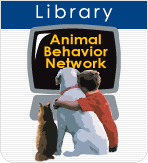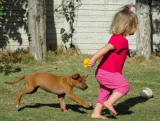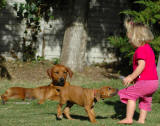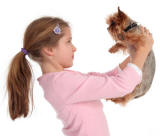|
Need Help? |
|
Call
1-800-372-3706
to
speak to a Veterinary Behavior Technician |
|
Paws for Help!
|
|

Click on Library Icon |
|
Help is at your
fingertips
by
library, email
and phone! |

Helpful Links
Play Biting


 |
|
Dog Behavior Library
|

Puppy
Biting
Puppy Exploration Biting
The definition of a
puppy, is that it still
has puppy canine teeth.
A puppy may bite someone
in an attempt to explore
the world. Part of this
exploration is to see
what happens when he
bites harder. If this is
the case, the best thing
to do is to allow some
gentle mouthing at first
(gentle exploration),
then when the biting
becomes even slightly
uncomfortable, get up
and move away from the
pup. This communicates
you are withholding
attention from him. This
is what happens if the
pup were exploring with
littermates. Try to
communicate that it is
the harder bite that
causes you to want to
stop playing. After
several seconds, return
to the pup, and allow
gentle mouthing again.
He may not understand at
first that it is the
pressure
that caused you to move
away. Keep repeating the
cycle until the pup has
a chance to understand
the situation.
Teaching the puppy to
bite gently is called,
"Bite Inhibition"
 In
most cases, the removal
of attention is the only
punishment needed for
this type of biting.
Escalate the punishment
if you are sure the pup
understands what you
want, yet is ignoring
your request.
(Insubordination) In
most cases, the removal
of attention is the only
punishment needed for
this type of biting.
Escalate the punishment
if you are sure the pup
understands what you
want, yet is ignoring
your request.
(Insubordination)
 Another
strategy for puppy
exploration biting is to
redirect the chewing
into a proper chew toy.
If you do this, allow at
least 10 seconds between
your exit and
whimpering, and
delivering the toy.
Otherwise the pup may
think it got a toy as a
result of biting you
("unintentional
reward"). Another
strategy for puppy
exploration biting is to
redirect the chewing
into a proper chew toy.
If you do this, allow at
least 10 seconds between
your exit and
whimpering, and
delivering the toy.
Otherwise the pup may
think it got a toy as a
result of biting you
("unintentional
reward").
The best thing to do is
to allow some gentle
mouthing at first
(gentle exploration),
then when the biting
becomes even slightly
uncomfortable, get up
and move away from the
pup. Puppy learns that
play stops if biting is
too hard. |
Puppy Play Biting

This biting starts out as a
playful nip. It means the puppy
is asking you to play with it.
Another posture to look for is
the "play bow" gesture. This is
when a dog slaps their front
legs on the ground with their
rump up and tail wagging. This
gesture, with or without a play
nip means "Please play with me."
 If
the pattern includes a nip, the
correct response is to
not play. If you do,
you are teaching the pup it is
not only okay to bite you, but
it is a good way to get your
attention. In addition to
stopping play, move away
(withhold attention). If you
begin this pattern early, biting
is easy to correct. If this has
been developed into a habit, it
gets harder and harder to
correct. If
the pattern includes a nip, the
correct response is to
not play. If you do,
you are teaching the pup it is
not only okay to bite you, but
it is a good way to get your
attention. In addition to
stopping play, move away
(withhold attention). If you
begin this pattern early, biting
is easy to correct. If this has
been developed into a habit, it
gets harder and harder to
correct.
 A
common mistake is to gradually
escalate the punishment A
common mistake is to gradually
escalate the punishment
The problem with gradual
escalation is that the pup does
not perceive the response as a
punishment, only as rougher
play. This not only does not
solve the problem, but
encourages the pup to bite
(play) even harder.

Puppy
Serious Biting (not from fear)
This is when the puppy is
saying, "You can't do that, and
I'm going to punish
you." This typically
occurs in older puppies who are
bred as guard dogs, and have not
been properly socialized and
handled. This is a serious
symptom of a dog that may become
uncontrollably aggressive in the
future if steps are not taken
immediately. The younger you
start with this type of symptom,
the easier it will be to
resolve. The best time to start
is when the puppy is six to
eight weeks of age.
 If
you respond with too
aggressively, you may increase
the aggressive nature of the
dog. This personality will
continue to protect you and your
house. The question becomes,
"Can you stop aggression when
you want to?" The goal is to be
able to control your own dog,
and be seen by your dog as a
leader. If the pup is biting
you, it may a symptom the pup
does not perceive you
as leader. If
you respond with too
aggressively, you may increase
the aggressive nature of the
dog. This personality will
continue to protect you and your
house. The question becomes,
"Can you stop aggression when
you want to?" The goal is to be
able to control your own dog,
and be seen by your dog as a
leader. If the pup is biting
you, it may a symptom the pup
does not perceive you
as leader.
Start with
these non-physical methods:
-
Start with hand
feeding, and
only giving food if it is
taken gently. (Close your
hand if the puppy acts
rough, open it if he's
gentle.) It is okay to
withhold food up to 24 hours
in a pup over eight weeks of
age for the purpose of
increasing motivation. Let
the pup know you control the
food. Begin to exchange food
for the right to handle and
control the pup. Reward only
what you want: calm
acceptance of your
leadership.
-
Begin Leadership and
Gentling Exercises.
Instructions are available
from the same source as this
page.
-
Don't "play fight" (box)
with the dog. This gives the
message it is okay to growl
and bite your hands.
-
Gently close the muzzle
closed as needed. This also
works if the pup is barking
inappropriately in your
presence. The best way to do
this is to use a Gentle
Leader (brand of head
collar) on the pup.
Use the leash to pull up and
close the muzzle.
Puppy Serious Fearful
Biting

This type of biting is common in
puppies that are either
naturally fearful, or in those
that have not been properly
socialized and gentled. They may
periodically become very tense,
and actively show fearful
postures such as crouching and
trying to get away. The puppy is
biting to try to make you go
away because it is afraid you
are going to harm it. Moving
away rewards the fearful
behavior, so the behavior is
strengthened and increased.
Never coddle and try to soothe
the pup. Reward calm,
relaxed behaviors with verbal
attention and treats.
Don't
punish fear biting. It only
makes the pup more fearful

Since the puppy wants to get
away from you, the strategy of
moving away doesn't work; in
fact, it rewards the biting. He
misinterprets this as
confirmation that you were
threatening. If this is the type
of biting you are experiencing,
don't try to force anything. Act
relaxed and initially ignore the
behavior, but don't
intentionally move away. Hand
feed as much as possible, and
only give attention when the pup
is acting confident or playful.
If the puppy is acting fearful,
instead of moving away, a better
response is to act "Jolly" or
very happy. The idea is to show
the puppy that as leader, you
don't see anything to be afraid
of.
 Other
strategies are to begin the
Elevation and Gentling Exercises
described in other pages
available from the same source
as this information. Other
strategies are to begin the
Elevation and Gentling Exercises
described in other pages
available from the same source
as this information.
Escalating Steps
Responding To Puppy Biting, not
fear motivated
-
Stop attention and move away
if Exploration Biting
-
Whimper and leave if Play
Biting. You are
communicating that the bite
hurt, and the pup used too
much pressure. Stop play and
move away from the pup for
several seconds until it
quiets down.
-
Begin to demonstrate
Leadership Exercises,
including requiring a SIT
before any food or
attention, and do daily
gentle massages as part of
the Leadership and Gentling
strategy.
-
If other
techniques don't work,
stop and consult a
behaviorist.
If Fearful
 Don't
use any physical correction, it
only makes the fear worse!
If you use verbal corrections,
watch for any submissive sign
and stop when you see them.
Submission signs are cowering,
lowered ears and tail and a "I'm
sorry" posture. As soon as you
see submission, stop since
continuing will cause the pup to
misunderstand and not trust you. Don't
use any physical correction, it
only makes the fear worse!
If you use verbal corrections,
watch for any submissive sign
and stop when you see them.
Submission signs are cowering,
lowered ears and tail and a "I'm
sorry" posture. As soon as you
see submission, stop since
continuing will cause the pup to
misunderstand and not trust you.
 Remember
that after verbal punishment,
allow five seconds of silence to
"wash" the pup's memory, then
call it to you and praise it
lavishly because it just did
COME when you asked. (The Make
up) Remember
that after verbal punishment,
allow five seconds of silence to
"wash" the pup's memory, then
call it to you and praise it
lavishly because it just did
COME when you asked. (The Make
up)
 If
the pup urinates when after
correction or when greeting you,
don't punish at all. Instead
implement the Gentling
Exercises. If urinating when
greeting, at first ignore the
pup until it is less excited,
and crouch down, look away, and
allow it to greet you more
casually. If this problem
continues, obtain the
information of "Submissive
Urination" from the same source
as this handout. If
the pup urinates when after
correction or when greeting you,
don't punish at all. Instead
implement the Gentling
Exercises. If urinating when
greeting, at first ignore the
pup until it is less excited,
and crouch down, look away, and
allow it to greet you more
casually. If this problem
continues, obtain the
information of "Submissive
Urination" from the same source
as this handout.
 The
key to dealing with a fearful
dog is to build its confidence The
key to dealing with a fearful
dog is to build its confidence
Do this by
gradually inducing the situation
that normally causes fear. Cause
enough to see the first signs of
fear. (Wide eyes, tense muscle
tone.) Don't allow a panic
attack. Then wait at that level
of stimulus and begin praising
and rewarding any relaxed or
confident posture. Once the pet
ignores the stimulus, move it
closer, and go very slowly over
many days of therapy.
If in doubt, consult a
behaviorist knowledgeable in
systematic desensitization and
counter conditioning.
|
|
|